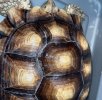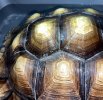Hello everyone! I'm dealing with an unexpected situation with my 6-year-old, 28 lb lady tortoise. Today I discovered an infected wound with rot and maggots on her shell. My partner and I spent the day cleaning the wound, flushing out maggots, and treating it with Betadine and silver sulfadiazine cream. I also administered Doxycycline orally from leftover medications. Currently she is being kept in our large screened porch, that’s clean, warm and pest free.
Our dog's vet is on vacation, and the local emergency vets can't help tortoises. I consulted with a vet familiar with her, but they're across the country since we moved a year ago.
We live in southern Maryland, and our tortoise, along with her sister, has a large fenced yard, a heated shed, and access to sunlight, proper temperatures, and a variety of greens. The shed is kept at 80 degrees at night and is well-ventilated. We clean waste regularly and ensure the area is pest-free.
I'm trying to figure out how this happened. The shed doesn't smell bad and is well-maintained. The tortoises are separated from our dogs but we have local wildlife like birds of prey, squirrels, gophers, and foxes. The tortoises get along well, and their previous vet said separation isn't necessary.
I'm seeking advice on how to prevent this from happening again. Thank you.
Our dog's vet is on vacation, and the local emergency vets can't help tortoises. I consulted with a vet familiar with her, but they're across the country since we moved a year ago.
We live in southern Maryland, and our tortoise, along with her sister, has a large fenced yard, a heated shed, and access to sunlight, proper temperatures, and a variety of greens. The shed is kept at 80 degrees at night and is well-ventilated. We clean waste regularly and ensure the area is pest-free.
I'm trying to figure out how this happened. The shed doesn't smell bad and is well-maintained. The tortoises are separated from our dogs but we have local wildlife like birds of prey, squirrels, gophers, and foxes. The tortoises get along well, and their previous vet said separation isn't necessary.
I'm seeking advice on how to prevent this from happening again. Thank you.



